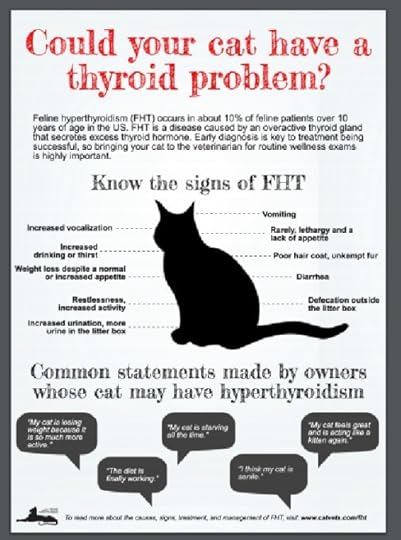Amy Shojai's Blog, page 82
May 19, 2016
Choose #SentinelSpectrum to Prevent Pet Parasites Year Round #ad
Choose #SentinelSpectrum to Prevent Pet Parasites Year Round #ad

Good bug protection isn’t magic–it’s common sense! (Image courtesy of DepositPhotos.com)
(whispering…a la Wizard of Oz)
Heartworms and tapeworms and fleas, OH MY!
Hookworms and roundworms and whips, OH MY!
Year round prevention of bugs? OH MY!
(singing)
We’re….OFF to see the Wizard,
It’s Sentinel® Spectrum® for bugs!
Hey, I couldn’t resist, y’all know about my theater background, and here in North Texas we’ve been dodging tornadoes lately.
Besides, when it comes to pet parasites, I just want to unleash the FLYING MONKEYS…except they’re liable to be plagued by fleas, too. Even flying monkeys deserve to be pest free, but there are still many pet parents who may not have all the facts about canine intestinal and external parasites and how to kick the bugs out. So…how much do YOU know?
 This post is sponsored by Virbac® Sentinel® Spectrum® and the BlogPaws® Pet Influencer Network™ . I am being compensated to help create awareness about protection against common parasites found in dogs but BLING, BITCHES & BLOOD only shares information relevant to our readers. More information about Sentinel Spectrum. Virbac is not responsible for the content of this article.
This post is sponsored by Virbac® Sentinel® Spectrum® and the BlogPaws® Pet Influencer Network™ . I am being compensated to help create awareness about protection against common parasites found in dogs but BLING, BITCHES & BLOOD only shares information relevant to our readers. More information about Sentinel Spectrum. Virbac is not responsible for the content of this article.
To help out your dog and me, too, (no cheating!) click this link for a Reader Survey and test your “pet pest I.Q.”–and then come on back and check to see if you nail the correct answers. Or should I say “squashed” the answers?
THE TRUTH ABOUT FLEAS
The flea’s flat body is armored with cuticle plates that make it nearly crush-proof, and the narrow profile promotes easy movement through fur. An adult flea can live from a few weeks to more than a year, but more typically lives about thirty days. Fleas set up permanent housekeeping on the pet, and stay there unless involuntarily evicted. However, adults represent only about 5 percent of the total flea population. The remaining 95 percent of the bug count is composed of immature life stages: eggs, larvae and cocoons.
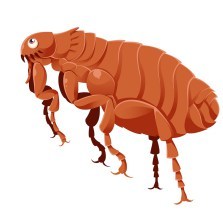
Fleas are NOT cute…and nothing to laugh about. (Image courtesy of DepositPhotos.com)
After mating, female fleas store sperm to use as needed; a blood meal stimulates her to lay eggs. She can produce over 2000 eggs in thirty days, and up to 50 each day. Eggs typically fall from the host, and may remain dormant in the environment (the carpet or yard) for as long as six months. But normally, eggs hatch into tiny, maggot-like larvae within one to two weeks. They are virtually invisible to the naked eye, and subsist on the waste passed by adult fleas (sometimes referred to as “flea dirt), and other organic material.
Larvae spin cocoons in about three weeks, where they mature into adults. From inside the cocoon, the flea’s antennae and bristles are able to detect body heat and odor, changes in light, touch and moisture, and even traces of carbon dioxide exhalation of a nearby host. This prompts the flea to emerge from the cocoon, and immediately snag a canine victim. The cycle from egg to adult takes only 21 days under ideal conditions. Meanwhile, all those immature stages can just hang around and wait for a good time to target your pooch.
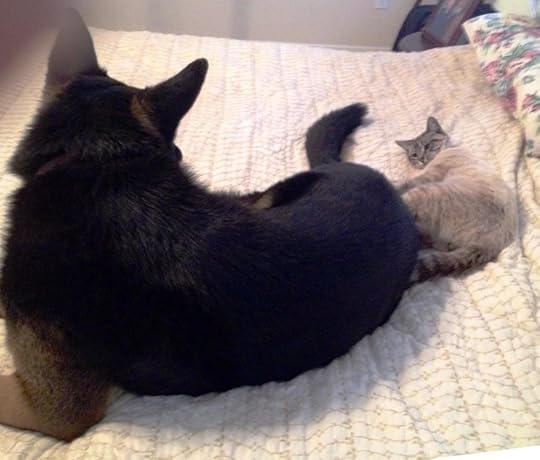
Fleas in my bed mean bug bites for me, too! (Image Copr. Amy Shojai, CABC)
Dogs that come indoors for even brief periods will seed flea eggs in your house which, given time to mature, quickly turn your house into a flea hotel. Fleas lurk in dog beds, (AND PEOPLE BEDS!), upholstery, carpeting, and even in your car! Vacuuming may even help spread the buggy bounty to other rooms in your house. That turns flea problems from a “seasonal itch” into a year round hazard.
WHY DOGS NEED
ALL YEAR HEARTWORM HELP
The weather is so mild here in Texas, that mosquitoes are year round pests, which makes canine heartworm disease a hazard all year long, for both indoor and outdoor pets. But the same is true if you live in cold northern states. Here’s why.
Dogs must be protected with a preventive heartworm treatment for at least 6 months after being last bitten by a mosquito, or you risk having heartworms develop. That’s because the medications can only kill the stages of a developing heartworm for the first ~3-4 months after a bite, and again once it becomes an adult by about 6 months after the mosquito bite.
That leaves a DANGER ZONE gap during which no drug is effective against these deadly parasites.

Magic deserves relief from parasite persecution! And…he can bring fleas INDOORS to my two indoor only cats. (Image Copr. Amy Shojai, CABC)
When an infected mosquito bites your dog in August, larvae are deposited upon the skin and gain entrance to the body through the bite wound left by the mosquito. The heartworm undergoes many more molts and development stages during the next several months, during which time it migrates inside your dog’s body.
Heartworm preventive can kill these baby worms during this migratory state, and prevent the parasite from reaching the heart and pulmonary arteries where it matures–it’s important, though, to treat a couple of months beyond the last mosquito bite of the season and on into the fall. But here’s the deal: how do you know the date of your dog’s last mosquito bite? Besides, that’s not how preventative is designed to work. Starting and stopping and missing the right timing risks your dog’s health.
Think about it. If you stop giving your dog preventive for half the year during the cold season, because you’re guessing mosquitoes aren’t around, you probably won’t kill the “baby worms” already percolating for potential havoc inside your canine buddy. In my part of the country (N. Texas), mosquitoes hang around even during the winter.
Because it’s so economical to prevent this threat, yet costs major $$ (and possibly your dog’s life) if you forget a dose, it’s really a no-brainer for me. Besides, getting in the habit of a healthy routine helps you remember and never forget to give your special dogs their preventative.
 The best and easiest way to protect your dog is to never skip a dose because heartworm preventative is most effective against infections that occurred in the month prior to taking the medicine. I treat Magical-Dawg year round with preventive to keep him flea and heartworm free. What about you?
The best and easiest way to protect your dog is to never skip a dose because heartworm preventative is most effective against infections that occurred in the month prior to taking the medicine. I treat Magical-Dawg year round with preventive to keep him flea and heartworm free. What about you?
Hey, did you take the SURVEY yet? Go ahead and do that now–you’ll be helping me out because your anonymous answers will become part of a fun info-graphic that I’ll share in a future post. So click this link to take the Reader Survey. And share the quiz!
I love hearing from you, so please share comments and questions. Do you have an ASK AMY question you’d like answered? Do you have a new kitten and need answers? Stay up to date on all the latest just subscribe the blog, “like” me on Facebook, and sign up for Pet Peeves newsletter. Stay up to date with the latest book give aways and appearances related to my September Day pet-centric THRILLERS WITH BITE!
This is a sponsored conversation written by me on behalf of Virbac® Sentinel® Spectrum®. The opinions and text are all mine.
AMY SHOJAI'S Bling, Bitches & Blood - Practical Solutions for Pets Problems & Publishing
May 18, 2016
Skunked! 3 Home Remedies to De-Stink Your Dog
Skunked! 3 Home Remedies to De-Stink Your Dog

Skunks come out in spring and stink up curious dogs
Karma-Kat loves watching the bunnies that play out on the back patio so I wasn’t concerned when he began chattering with excitement—until I noticed THIS bunny had a long fluffy black and white tail. Yes, a skunk has set up housekeeping next to our house. Hoo boy.
SKUNKED DOGS & REPEAT OFFENDERS
Last year around this time, Magical-Dawg found a skunk—again. We’ve had to de-stink him several times over the years, and one summer he got “blasted” three separate times. You’d think dogs would learn after one skunk encounter, but time after time he sticks his nose in rude places and gets rewarded with skunky consequences. So last week after my husband noticed one of the cute lil’ black and white critters wandering around in the back pasture, we’ve since then made sure Magic is under leash control until the coast is clear.
I suspect that the heavy rains have evicted many little black and white furry families from their heir homes. This one Magic found pretty close to the house, rather than the distant field that’s on pretty low (currently soggy) ground. Usually hunting dogs get nailed most often since they’re exposed to wildlife as they hunt. But hungry skunks won’t hesitate to munch pet food left out and can even sneak into your house (yikes!) through a pet door.
Dogs aren’t dumb. Well, most are not…so you’d think they’d learn from one (or two, or five!) encounters. Yet the dogs continue to push the sniff-envelope and continue to get nailed. It’s not entirely their fault, even though skunks give fair warning with stomped feet, turning around and holding the tail high. But this elevated tail poised to launch its smelly cargo sends mixed signals to pets.
WHY DOGS GET SKUNKED
A straight-up tail is a greeting behavior for cats, and for dogs a high-held wagging tail begs for a greeting sniff. The skunk has shown the equivalent of a dog offering to shake hands, and gets his feelings hurt when he misunderstands the skunk’s invitation. It’s simple mis-communication.
Skunks have musk glands on each side of the anus. These glands are equipped with retractable ducts. They can take aim and spray the stink a distance of 10 to 15 feet, so even standoffish pets are liable to get nailed.
Skunk spray contains thiols, an organic compound composed of a sulfur atom attached to a hydrogen atom attached to a carbon atom. The same types of compounds create stinky breath or flatulence. Thiols have a lingering rotten egg odor, and the skunk’s oily secretion makes it difficult to get rid of. Skunk spray is so pungent, a concentration of one in 10 parts per billion can make humans gag. Just think how obnoxious or downright painful the smell is to your pet’s nose.
A bath alone generally won’t do the job. The oily secretions can be difficult to wash away, and the thiols are impossible to perfume or wash off. Usually a commercial de-skunking solution will be needed, one that incorporates odor neutralizers specially designed to eliminate the pungent aroma.
Perform clean up outside, too, or you’ll need to deodorize your entire house after scrubbing the pet. Wear comfortable, disposable old clothes and gloves because your dog will transfer odor to you during the bathing process. Trust me on this!
Oh, and do NOT let the dog back into the house until after the bath. Otherwise, you’ll have to deal with the skunk smell in the air and potentially your carpet and furniture when the dog tries to rub off the odor. The last time this happened I got a Fresh Wave candle burning, and a CritterZone odor neutralizer running in addition to spritzing odor neutralizers around the kitchen.

Skunked dogs require multiple sudsing and rinsing cycles.
3 HOME REMEDIES TO
DE-STINK SKUNKY DOGS
What if you don’t have handy-dandy products available that are designed to keep skunk smell at bay? Here are a few options.
Tomato Juice. A tried and true home remedy is a tomato juice soak. Wash your puppy first with pet shampoo and towel him dry. Then douse him with the juice and let it soak for ten or fifteen minutes. Rinse him off and suds again with the regular shampoo. Alternate the tomato juice soak with the shampoo bath until he’s less pungent. Be warned, though, that white and light colored pets may turn temporarily pink from this treatment.
Massengill Douche. Professional groomers often recommend Massengill brand douche to get rid of skunk odor. Mix two ounces of Massengill to a gallon of water for small dogs—double the recipe for bigger pups—and pour over the washed pet. Let the solution soak for at least fifteen minutes. Then rinse with plain water, and bathe with normal shampoo once more.
Chemistry Cure. You can also use chemistry to neutralize the thiols. Mix one quart of 3% hydrogen peroxide with ¼ cup of baking soda, and one teaspoon of pet shampoo (any kind will work). Apply to the pet’s wet fur, allow the mix to bubble for three or four minutes, then rinse thoroughly. This recipe, created by chemist Paul Krebaum, works better than anything on the market. You can’t buy it, though, because the formula can’t be bottled. It explodes if left in a closed container. So if your pet is skunked, mix only one application at a time. Otherwise you’ll be cleaning up more than just the pet.
What about the skunk under our patio? Well, she (yes, it’s obviously a SHE) will be there for the foreseeable future. I watched her dive under the AC unit that’s probably been flooded out, and come out carrying a baby. She carried baby skunk to the new digs (pun intended) beneath the patio, out of the rain. And she repeated the maneuver at least two more times. Magic won’t be using the back door anytime soon.
Meanwhile, Karma has a new black and white “bunny” friend. I think I’ll call her Susie.
Have you or your pets ever been skunked? Ever had wildlife move into your neighborhood? Do tell!
I love hearing from you, so please share comments and questions. Please note that I earn a small percentage from affiliate links to books or other products which are mentioned from time to time in my posts. Do you have an ASK AMY question you’d like answered? Do you have a new kitten and need answers? Stay up to date on all the latest just subscribe the blog, “like” me on Facebook, and sign up for Pet Peeves newsletter. Stay up to date with the latest book give aways and appearances related to my September Day pet-centric THRILLERS WITH BITE!
AMY SHOJAI'S Bling, Bitches & Blood - Practical Solutions for Pets Problems & Publishing
May 10, 2016
Catnapped? Shadow to the Rescue!
Catnapped? Shadow to the Rescue!
 Catnapped? Shadow to the rescue, in HIDE AND SEEK. And then YOU to the rescue for this pet writer. Wow…
Catnapped? Shadow to the rescue, in HIDE AND SEEK. And then YOU to the rescue for this pet writer. Wow…
I want to THANK YOU (yes, I mean YOU!) for adopting my debut thriller LOST AND FOUND back in 2012 when it first released, and again this past week when all the Ebook formats dropped to free.
Yes, free. It’s still free, and will remain free for the foreseeable future. 
May 9, 2016
Hot Weather Safety for Pets

Hot cars kill dogs.
I live in N. Texas where it’s not unusual for weather to have everyone hot under the collar. Hot weather safety for pets around here is a matter of life and death for cats and dogs. Just imagine how pets feel with a fur coat.
Cats and dogs risk sunburn, pad burns and life-threatening heatstroke without proper precautions. Never leave your pet unattended in a hot car. These tips can help you prevent problems, or even save your pet’s life.

Paws are not as tough as you’d think.
PAD BURNS
Dogs don’t get pad burns very often because they flinch away from heat. But cats love heat and often lounge on surfaces up to 126 degrees. They won’t feel themselves getting burned.
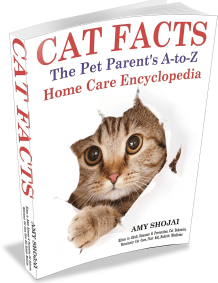
Learn more about heat-loving cats in CAT FACTS.
Both dogs and cats can suffer pad burns from walking on hot pavement, especially when not offered the option for cooler pathways.
Do the barefoot test. If pavement feels too hot for you, it’s also a problem for pets. Prevent pad burns by making shaded and/or grassy pathways an option. For pad burns, apply an aloe vera ointment three to five times a day to help shorten healing time. It’s safe for pets to lick off in small amounts, too.
SUNBURN
Fur protects most dogs and cats from sunburn, but thinly furred ear tips, bridge of the nose, and the tummy can get burned. White pets are at highest risk. Dogs who sleep on their back and sun-worshiping cats seem affected most often.
Sunburn isn’t a medical emergency, but it can be painful. The skin turns red, can blister, become crusty, and peel. Kitty ears curl and literally turn crispy.
Cold water spray from a plant mister every half hour or so works great to soothe sunburned dogs, but cats hate getting sprayed. Witch hazel helps cool inflamed skin by evaporation and doesn’t sting like alcohol. Dab some on affected areas with a cotton ball three or four times a day to soothe the burn.
Sunburn dries out the skin. Aloe vera creams not only moisturize but also help heal burns faster. These products often contain vitamin E that speeds healing and soothes burns.

Heat stroke is no laughing matter–and panting won’t help.
HEATSTROKE
Pets don’t sweat. To cool off, dogs pant so the moisture evaporates off the tongue. Cats lick fur and evaporation keeps body temperatures at a safe level. But for grooming or panting to work, the outside air must be a lower temperature than the pet’s normal body temperature (101-102.5 degrees). When self-cooling fails, heatstroke kills in less than 15 minutes.

Get the FACTS about all your dog health concerns!
Cars become deathtraps. When the temperature reaches 78 degrees, cars sitting in the shade reach 90 degrees in no time. But if parked in the sun on a 78-degree day, car temp soars to 168 degrees within minutes. That cooks the brain, leaving irreversible damage.
Signs of heatstroke include rapid panting, a bright red tongue and gums, sticky saliva, and body temperatures of 104-106 degrees. Severe cases of heatstroke may prompt body temperatures of 110 degrees or higher.
Unless you live only five minutes away, give first aid before heading to the emergency room. To save your pet’s life, reduce body temperature to 104 degrees and then get follow-up medical care.
For mild heatstroke, offer water or Gatorade cooler than the outside temperature. Wrap the pet in cold wet towels. Bring him into an air-conditioned space and turn on a fan so the air he breathes is cooler than his body to reduce internal temperature naturally.
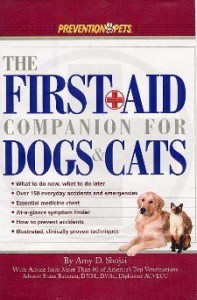
First aid saves lives–from hangnails to gunshots to animal bites, know what to do!
For severe heatstroke (body temperatures over 106 degrees), douse the pet with cool water from the hose, or dunk him in the bathtub or sink. Ice packs placed in the “armpits” or groin (near major blood vessels) help chill the blood so it cools the pet during circulation.
COOL PET TIPS
Prevent heat stroke by providing shade for outside pets, along with plenty of cool water. Specialized attachments turn outside faucets into 24/7 pet drinking fountains so you won’t have to worry about spilled bowls. Misting fans and aerosols lower the temperature and keep pet fur damp to cool fur through evaporation. Misters can be placed on the porch, deck or near your dog’s pen.
Invest in cooling bandannas and collars, body wraps, and pet mats from pet products outlets. Or just provide a child’s wading pool, fill it daily with cool water and let the water-puppies splash to their heart’s content.

A safe place to cool off is great for dogs during hot weather.
Prevent problems altogether by keeping cats and dogs in air-conditioned spaces when the temperatures become dangerous. The most dangerous times of day for sunburn are 9:00 a.m. to 3:00 p.m. so schedule cooler times for outdoor excursions.
I love hearing from you, so please share comments and questions. Please note that I earn a small percentage from affiliate links to books or other products which are mentioned from time to time in my posts. Do you have an ASK AMY question you’d like answered? Do you have a new kitten and need answers? Stay up to date on all the latest just subscribe the blog, “like” me on Facebook, and sign up for Pet Peeves newsletter. Stay up to date with the latest book give aways and appearances related to my September Day pet-centric THRILLERS WITH BITE!
AMY SHOJAI'S Bling, Bitches & Blood - Practical Solutions for Pets Problems & Publishing
May 6, 2016
Hyperthyroid Cats & Mother’s Day
Hyperthyroid Cats & Mother’s Day

Hyperthyroid cats is a fact of life for people lucky enough to have an old cat. Most of y’all who read this blog know that Seren-Kitty is a senior citizen girl, and as such she’s at risk for hyperthyroid disease. At her last checkup, we ran tests to check and–thank goodness!–she’s normal and doesn’t have that issue. That makes this Mother’s Day a happy one for this “cat mom.”
 That’s not the case with many older cats. There are a couple of causes of the condition, with about 95% of cases due to a benign tumor on the cat’s thyroid, which is highly treatable. I write about feline hyperthryoidism signs, diagnosis and treatment in my CAT FACTS and also my COMPLETE CARE FOR YOUR AGING CAT books. (Both are way-cheap in the Ebook versions *s*).
That’s not the case with many older cats. There are a couple of causes of the condition, with about 95% of cases due to a benign tumor on the cat’s thyroid, which is highly treatable. I write about feline hyperthryoidism signs, diagnosis and treatment in my CAT FACTS and also my COMPLETE CARE FOR YOUR AGING CAT books. (Both are way-cheap in the Ebook versions *s*).
Learning about cat care issues is an ongoing passion at my house. Maybe you know a “cat mom” that needs some solid information to keep her cat-babies healthy and happy.
 I’m a member of the AAFP’s Cat Friendly Practice Advisory Council, so I’m always happy to share great info from this organization. AAFP has created a feline hyperthroid disease brochure that you can download with all the details. They’ve also shared this neato infographic, below, for quick reference.
I’m a member of the AAFP’s Cat Friendly Practice Advisory Council, so I’m always happy to share great info from this organization. AAFP has created a feline hyperthroid disease brochure that you can download with all the details. They’ve also shared this neato infographic, below, for quick reference.
Do you have an aging cat? Has your kitty shown telltale signs of problems? Or maybe your feline kid has been diagnosed and gone through treatment for feline hyperthyroidism. Please share your experiences in the comments–it could help other “cat moms” out there!
I love hearing from you, so please share comments and questions. Do you have an ASK AMY question you’d like answered? Do you have a new kitten and need answers? Stay up to date on all the latest just subscribe the blog, “like” me on Facebook, and sign up for Pet Peeves newsletter. Stay up to date with the latest book give aways and appearances related to my September Day pet-centric THRILLERS WITH BITE!
AMY SHOJAI'S Bling, Bitches & Blood - Practical Solutions for Pets Problems & Publishing
May 5, 2016
Thriller Thursday: Theater, Horses & Murder = One Dead, Two to Go
Thriller Thursday: Theater, Horses & Murder = One Dead, Two to Go

Chills, thrills and spills with Thriller Thursday by Amy Shojai
THRILLER THURSDAY is a new occasional feature of Bling, Bitches & Blood. As a member of International Thriller Writers and alumni of the ITW Debut Author Program, it is my honor to showcase select ITW authors and books participating in the ITW Bloggers Program. If you love reading great books as much as I do, check out my Spotlight Guest Elena Hartwell!
Now here’s something you don’t see every day–a playwright deciding to write thrillers. (I’ve found my identical twin separated at birth! Ha!) When I learned that Elena shared my love of theatric-icity, I had to ask for more information. Take it away, Elena!

Elana & Chance
Question: What do theater, horses, and murder have in common? Answer: Author, Elena Hartwell.
My writing career started in the theater, as a director, producer, and educator. As a playwright, I’ve had several productions around the US and abroad. Sometimes it was satisfying and wonderful. Sometimes it was painful and always required I “sell” my script over and over and over to the next theater down the road. For twenty years, I worked teaching theater, directing, and producing.
But my heart always returned to the writing.
Plays are satisfying, but require a village to “complete.” So I started my first novel. It was a 120,000-word mystery. I was worried it was too short. I’ve since learned most first time mysteries are 65-70,000 words. I learned a lot with that first book. Plays are in permanent present tense and each character has their own POV, because they are inhabited by individual actors. Novels, on the other hand, are usually in past tense and with a specific POV. I learned the difference between writing atmosphere and writing specific descriptions.
I wrote another book. It was better. But didn’t sell. So I wrote a third book and landed an agent. I thought I’d “made it.” But that book didn’t sell either. So I wrote a fourth book and pitched it to an Independent press. One Dead, Two to Go hit the shelves on April 15th.

Elena’s husband J.D. and Jasper
So how do you stay grounded in a world where you have little control over your own destiny? My method is my horses. Two years ago, I met an Arabian gelding named Second Chance. He was given that name because he survived a kill pen, where he was to be sold for dog food. He arrived at the equine rescue where I volunteered and I fell in love. Unwilling to let anyone touch him, he walked over and put his head on my shoulder the first time we met. We’ve been together almost every day since. In December, my husband and I bought Jasper, a dynamic, confident ranch horse we found at the end of a dirt road on the Nevada/Utah border. Now I share my love for these magnificent animals with him. No matter what happens in the publishing world, I stay grounded. For that I am eternally grateful.

Thriller writer Elena Hartwell
MORE ABOUT THE AUTHOR: Elena Hartwell was born in Bogota, Colombia, while her parents were in the Peace Corps. Her first word was “cuidado.” At the age of nine months, she told two men carrying a heavy table to be careful in their native tongue. She’s been telling people what to do ever since. After almost twenty years in the theater, Elena turned her playwriting skills to novels and the result is her first book “One Dead, Two to Go.” The Eddie Shoes Mystery Series launches April 15, 2016, to be followed by “Two Dead Are Better Than One” and “Three Dead, You’re Out.” For more information on Elena, please visit elenahartwell.com or like her Facebook Page ElenaHartwellAuthor and follow her on Twitter and at Pinterest. You may get to see cute pictures of her dog and her horse.
Buy the book at AMAZON HERE, and also at BARNES & NOBLE HERE.
HERE’S WHAT READERS SAY…
“One Dead, Two To Go is smart, page-turning fun, with the most feisty and likable P.I. since Kinsey Millhone. Looking for your next favorite detective series? Look no further.” —Deb Caletti, National Book Award finalist and author of He’s Gone
“Elena Hartwell doesn’t just burst onto the scene with this clever mystery novel—she kicks the door in and holds the reader at gunpoint.” —Peter Clines, Award-winning author
“The writing is cinematic and vivid, the characters well-drawn, but the dynamic between Eddie and Chava, which reminded me fondly of Cagney and Lacey, is what makes the story. Fans of the Stephanie Plum series by Janet Evanovich should de nitely check out One Dead, Two to Go. Recommended.”—Max Everhart, author of the Eli Sharpe Mystery series
“Unlike the standard-issue PI, Eddie seems allergic to guns and violence and worries about a bad haircut as much as stalking danger. Funny, clever, and full of grabbing plot twists, Elena Hartwell’s One Dead, Two To Go, the debut novel in her Eddie Shoes series, takes the mystery lover into unexpected territory, including the introduction of Chava, the intrepid mother who is kicked out of Vegas by the Mob and shows up uninvited on Eddie’s doorstep. is is a fast, memorable and entertaining read. Warning: you’ll want more.” —Scott Driscoll, author of Better You Go Home
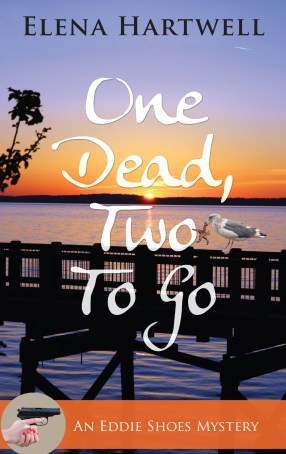
Elena Hartwell’s debut novel One Dead, Two to Go
SYNOPSIS: Private Investigator Edwina “Eddie Shoes” Schultz’s most recent job has her parked outside a seedy Bellingham hotel, photographing her quarry as he kisses his mistress goodbye. This is the last anyone will see of the woman… alive. Her body is later found dumped in an abandoned building. Eddie’s client, Kendra Hallings, disappears soon after. Eddie hates to be stiffed for her fee, but she has to wonder if Kendra could be in trouble too. Or is she the killer?
Eddie usually balks at matters requiring a gun, but before she knows it, she is knee-deep in dangerous company, spurred on by her card-counting adrenaline-junkie mother who has shown up on her doorstep fresh from the shenanigans that got her kicked out of Vegas. Chava is only sixteen years older than Eddie and sadly lacking in parenting skills. Her unique areas of expertise, however, prove to be helpful in ways Eddie can’t deny, making it hard to stop Chava from tagging along.
Also investigating the homicide is Detective Chance Parker, new to Bellingham’s Major Crimes unit but no stranger to Eddie. Their history as a couple back in Seattle is one more kink in a chain of complications, making Eddie’s case more frustrating and perilous with each tick of the clock.
Buy the book at AMAZON HERE, and also at BARNES & NOBLE HERE.
I love hearing from you, so please share comments and questions. Do you have an ASK AMY question you’d like answered? Do you have a new kitten and need answers? Stay up to date on all the latest just subscribe the blog, “like” me on Facebook, and sign up for Pet Peeves newsletter. Stay up to date with the latest book give aways and appearances related to my September Day pet-centric THRILLERS WITH BITE!
AMY SHOJAI'S Bling, Bitches & Blood - Practical Solutions for Pets Problems & Publishing
May 1, 2016
Dogs & Cats & Bad Guys, Oh My! LOST AND FOUND is FREE
Dogs & Cats & Bad Guys, Oh My! LOST AND FOUND is FREE
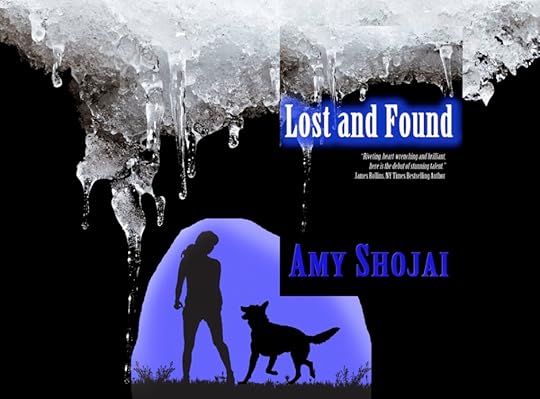
The 1st installment of Shojai’s dark, female-driven domestic thriller series featuring pet-centric plots
LOST AND FOUND is FREE!
James Rollins said, “Riveting, heart-wrenching, and brilliant, here is the debut of a stunning talent.”
I’m delighted to announce that LOST AND FOUND is now available for FREE for your reading pleasure. You can find the FREE Ebook version at these great sites:
Amazon Kindle
Barnes & Noble Nook
iBookStore
A young woman races a Texas blizzard to save her autistic nephew from a deadly secret others will kill to protect–and the service dog she’s trained finds his true purpose, when he disobeys.
Animal behaviorist September Day has lost everything–husband murdered, career in ruins, confidence shot–and returns home with her trained Maine Coon cat Macy to Texas to recover. She’s forced out of hibernation when her nephew Steven and his autism service dog Shadow disappear in a freak blizzard. September and Shadow forge a stormy partnership to rescue the missing … But can they also find the lost parts of themselves?
Again, get your free copy at the links below–Dang, I hope you like it! With 75+ positive reviews, lots of folks have already enjoyed this dog-centric story as well as the following stories, HIDE AND SEEK and SHOW AND TELL. Please SHARE this post with anyone who enjoys a pet-centric roller-coaster suspense!
Amazon Kindle
Barnes & Noble Nook
iBookStore
p.s., If you prefer nonfiction, don’t forget to enter the give-away for DOG FACTS and CAT FACTS here.
I love hearing from you, so please share comments and questions. Do you have an ASK AMY question you’d like answered? Do you have a new kitten and need answers?Stay up to date on all the latest just subscribe the blog, “like” me on Facebook, and sign up for Pet Peeves newsletter. Stay up to date with the latest book give aways and appearances related to my September Day pet-centric THRILLERS WITH BITE!
AMY SHOJAI'S Bling, Bitches & Blood - Practical Solutions for Pets Problems & Publishing
April 29, 2016
Enter Goodreads Contest: Win Dog Facts & Cat Facts in Time for Mother’s Day
Enter Goodreads Contest: Win Dog Facts & Cat Facts in Time for Mother’s Day

For pet-moms, every day is Mother’s Day.
I’m celebrating the release (and great reviews!) of my two latest books with GIVE AWAYS! Hey, you can enter for yourself, for your dog or cat, or tell others about the chance to win a PAW-tographed print copy of these books.
With Mother’s Day just around the corner, wouldn’t one of these books make a great gift for a pet-mom? *s*
Of course, if you don’t want to rely on chance, you can order Cat Facts here or for dog lovers, Dog Facts here for the pet-loving folks in your life, and get it to them in time.
Goodreads Book Giveaway

Dog Facts
by Amy Shojai
Giveaway ends May 16, 2016.
See the giveaway details
at Goodreads.
Goodreads Book Giveaway

Cat Facts
by Amy Shojai
Giveaway ends May 16, 2016.
See the giveaway details
at Goodreads.
I love hearing from you, so please share comments and questions. Do you have an ASK AMY question you’d like answered? Do you have a new kitten and need answers?Stay up to date on all the latest just subscribe the blog, “like” me on Facebook, and sign up for Pet Peeves newsletter. Stay up to date with the latest book give aways and appearances related to my September Day pet-centric THRILLERS WITH BITE!
AMY SHOJAI'S Bling, Bitches & Blood - Practical Solutions for Pets Problems & Publishing
April 25, 2016
Writer Beware: Publish America Now America Star Books
Writer Beware: Publish America Now America Star Books

Writing can be like swimming in shark-infested waters.
I’m likely writing and preaching to the choir here, but when sharks start circling, it bears repeating especially for the folks who may be treated like chum. It’s not fun being targeted by the sharks, and even experienced writers and authors fall prey to some of the crappiocca floating around these days.
Yes, there is DANGER out there for the unwary and eager authors. Certainly, you can choose your own path to publication, and far be it from me to say what is the best choice for anyone but myself. That said, PLEASE be informed. There are some well known companies that have earned either a great or abysmal reputation and when you spend all your blood-sweat-and-tears on your baby-book, it’s important to know the difference.
Publish America has been around for many years. Once self published writers took the reins of their own careers and learned they could accomplish more for less $$ on their own or by hiring pros, such companies turned to advertising and marketing packages to make money. Sure, it’s fine to hire help to market and promote your work–but again, be informed. High price does not equal high quality.
I love the Writer Beware site and strongly urge all writers to bookmark the site. It’s sponsored by the Science Fiction and Fantasy Writers of America and founded by A.C. Crispin and Victoria Strauss. So when I got the (below) letter last week, and it didn’t pass the sniff-test, I visited the Writer Beware site and found out this is old news but new to me. Here’s their post on the subject.
Take a look at the email I got yesterday, copied below. I found it interesting that this company that used to do nothing but publish (for a high fee), now says it publishes for free–and offers to promote my indie book for free.
Except my 1st Aid book is NOT an “indie” title.
All they want is to add my name to their marketing solicitation list–but they’ve already GOT my email and sent that letter in a marketing blast. So why reach out? Why do you think? Baiting the hook? Hmnnn.
Or do they want permission to use my pet 1st aid book in their marketing at this event? GAK! no-no-no-no-no!
My name is Jackie Velnoskey. I saw that you have written The First Aid Companion for Dogs & Cats. My question for you is: may I promote the book at the American Library Association’s Annual Conference & Exhibition in Orlando in June? It costs you nothing. All I’m asking you in return is if we may add you to our book marketing email list.
Amy’s Note: American Library Association is a legit organization, as is its conference. Anyone can pay to exhibit there.
We would like to include your work in the Hot Indy Author Guide that we’re displaying and distributing during the ALA event. This option is free. Check out our Facebook page (URL REDACTED) when we report live from Orlando where over 150,000+ are expected to attend.
At America Star Books we have a book promotion department that does nothing but offering book promotion at the lowest fees in the nation. We attend all of the big fairs and festivals: Book Expo America, London Book Fair, Frankfurt Book Fair, Miami Book Fair International, the American Library Association mid-winter and annual Conferences, Baltimore Book Festival, and so on.
All I am asking you at this time is if we may add you to our email list when we issue our next book promotion offers. You may at any time unsubscribe, and we will promptly cease sending you any further emails. America Star Books has been around for more than fifteen years, serving over 60,000 authors. Participating in book promotion is entirely optional.
Thank you for considering this opportunity. I am looking forward to hearing back from you.
Jackie Velnoskey
America Star Books Special Services, manager
301-***-****

Snakes cannot help their nature…steer clear!
Hey, it’s complicated and can be hard to recognize some of the bad actors because…well, because some of them have joined forces with other well known publishing houses to give themselves legitimacy. Another of my favorite writing blogs is written by author David Gaughrin, and he has a take-no-prisoners approach to calling out the bad actors. Check out his post here about Author Solutions (another infamous example).
I realize this is not an in depth explanation or recommendation for what you SHOULD do. Others have written with more detail and insight, which is why I encourage you to check out both David’s and the Writer Beware blogs. Also, subscribe to email lists so that when something like this comes up, simply ASK if anyone on the list can tell you anything about the company. The indie community of writers is one of the most generous and giving I’ve ever seen, and those with more experience typically will offer feedback and help to those who genuinely want help.
Your turn–what do you think? Any horror stories you’d care to share…or even better, success stories? I love celebrating writer-ly success because DANG, it’s not an easy path to get published.
It’s up to all of us to watch each other’s backs and call FOUL when someone sets out to prey on the unwary.
I love hearing from you, so please share comments and questions. Do you have an ASK AMY question you’d like answered? Do you have a new kitten and need answers? Stay up to date on all the latest just subscribe the blog, “like” me on Facebook, and sign up for Pet Peeves newsletter. Stay up to date with the latest book give aways and appearances related to my September Day pet-centric THRILLERS WITH BITE!
AMY SHOJAI'S Bling, Bitches & Blood - Practical Solutions for Pets Problems & Publishing
April 21, 2016
Dogs Eating Poop? Stop Litter Box Grazing With The Door Buddy #ad
Dogs Eating Poop? Stop Litter Box Grazing With The Door Buddy #ad

Dogs love the (ahem) taste of kitty “treats” from the cat box.
 This post is sponsored by The Door Buddy. I am being compensated to help create awareness about pet proofing and kid proofing cat litter boxes but BLING, BITCHES & BLOOD only shares information relevant to our readers. The Door Buddy is not responsible for the content of this article.
This post is sponsored by The Door Buddy. I am being compensated to help create awareness about pet proofing and kid proofing cat litter boxes but BLING, BITCHES & BLOOD only shares information relevant to our readers. The Door Buddy is not responsible for the content of this article.
Most new owners are delighted by puppy antics but dogs eating poop prompts anything but smiles. My own darling Magic indulged when he turned six months old. He’d make a beeline to visit his horse buddy next door and find the nifty treats she left on the ground. After these nasty snacks Magic always tried to kiss everybody on the lips, yuck! Thank doG, he finally outgrew the behavior…
Until recently when he relapsed. Urk! That’s why I’m thrilled today to be reviewing The Door Buddy.
WHY YOUR DOG EATS POOP
Dogs commonly eat their own or another animal’s droppings (coprophagia). This is normal behavior for mom-dogs that must clean up after their babies, and some of the pups may end up mimicking this behavior. It first appears in pups at about four to nine months of age. And generally the dog outgrows the behavior. There are a number of ways to deter the behavior in puppies, discussed in my book Complete Puppy Care.
DOGS EATING FROM CAT LITTER BOX
 For adult dogs, though, it’s not unusual for the cat’s litter box to be treated as a canine snack bar. That’s because cat food contains more protein than dog food, and as a result, feline waste tastes good to dogs. The nasty habit is not only unsanitary it puts Sheba’s tail in a twist to have a dog messing with her toilet. Cats pestered in their bathroom look for another place to “go” such as behind the sofa.
For adult dogs, though, it’s not unusual for the cat’s litter box to be treated as a canine snack bar. That’s because cat food contains more protein than dog food, and as a result, feline waste tastes good to dogs. The nasty habit is not only unsanitary it puts Sheba’s tail in a twist to have a dog messing with her toilet. Cats pestered in their bathroom look for another place to “go” such as behind the sofa.
And yep, Magic has started to *ahem* indulge because my old lady cat Seren’s litter box has become much more aromatic of late. She may also have a change in digestion that makes her waste more appealing. Whatever the reason, Magic has begun to make a habit of running up the stairs to my office to check out her private potty.
It’s not only dogs that investigate the kitty potty, and hiss off the cat–and risk illness, too. Human babies and toddlers, just like puppies, love to explore and guess what ends up being tasted? Double urk!
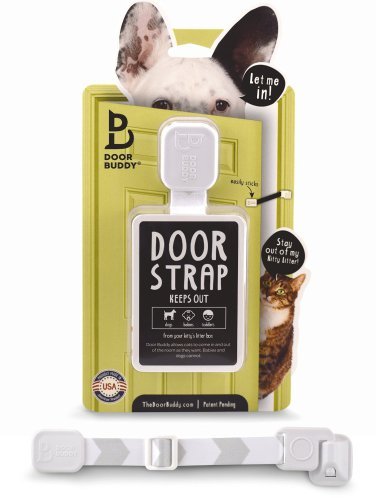
The Door Buddy is an innovative strap that controls the size of door openings.
What’s a caring parent (of two-legged or four legged “kids”) to do? Enter the Door Buddy.
CLICK HERE TO READ THE DOOR BUDDY STORY
I already had a couple of ASK AMY videos on YouTube about the issue, and received an email from one of my viewers. Scott Johnson wrote to tell me about his product, The Door Buddy, and offered to send me a sample to review. I was intrigued.
The Door Buddy is a management tool that helps you control access to the cat’s litter box and/or food bowl–or kitty’s favorite room. Essentially, it’s a peel-and-stick low-tech and economical solution that installs in minutes. The adjustable strap allows you to determine the size of the door opening, so that your smaller cat can come and go (and eat or eliminate in peace) while preventing larger animals–including babies and toddlers!–from entering the area.
The Door Buddy requires no fancy installment, and is way less expensive than pet gate barriers or “cat flap” and doggy doors that often are recommended. I was concerned that 90-pound Magic would bulldoze his way through, since no screws attach the strap to the door and frame. It’s likely that a very determined large dog could get through–but for smaller dogs and those like Magic that only require a reminder, The Door Buddy works like a charm.
Check out the video, below, for more details on the Door Buddy and how easy it is to install. I love the video clips at the end of the kiddies, and bet you will, too. Oh…and then scroll on down for your chance to WIN a Door Buddy to try out at your house. You can also see my video review below with MY fur-kids and how they react to the Door Buddy.
At my house, my Karma-Kat is a bit of a piggy when it comes to Seren-Kitty’s food bowl. Magic has taken to doing a paws-up on the table where I feed the cats, and reeeeeching over to clean out their bowls (sheehs, there’s another use for me!). Because my two cats are enough different in size, the Door Buddy works quite well to offer Seren access while limiting Karma’s ability to gnosh from the room where she’s fed. 
Do you have dogs that pester your cat during dinner or potty duty? Or maybe you have Mutt-and-Jeff size dogs that need to have separate feeding ops? I could see the Door Buddy working particularly well for multi-pet homes–but also as a boon to keeping your cats calm when the grandkids come to visit!
Want to try out the Door Buddy? Scott is hosting a Door Buddy GIVE AWAY of the product to five lucky winners, so you can try out this innovative new product.
GO HERE and enter for your chance to win 1 of 5 Door Buddy products.
Now take a minute to watch the video, below (with Seren-Kitty, Magical-Dawg & Karma-Kat). What do you think? Do tell! Yes, I look a bit tired because my video software was being obnoxious (much easier to train cats and dogs, LOL!)
Final note: If you’re attending the Cat Writers’ Association Awards Banquet this year, you can say “howdy” to Scott in person (or is that “purr-son?”).
I love hearing from you, so please share comments and questions. Do you have an ASK AMY question you’d like answered? Do you have a new kitten and need answers? Stay up to date on all the latest just subscribe the blog, “like” me on Facebook, and sign up for Pet Peeves newsletter. Stay up to date with the latest book give aways and appearances related to my September Day pet-centric THRILLERS WITH BITE!
AMY SHOJAI'S Bling, Bitches & Blood - Practical Solutions for Pets Problems & Publishing



